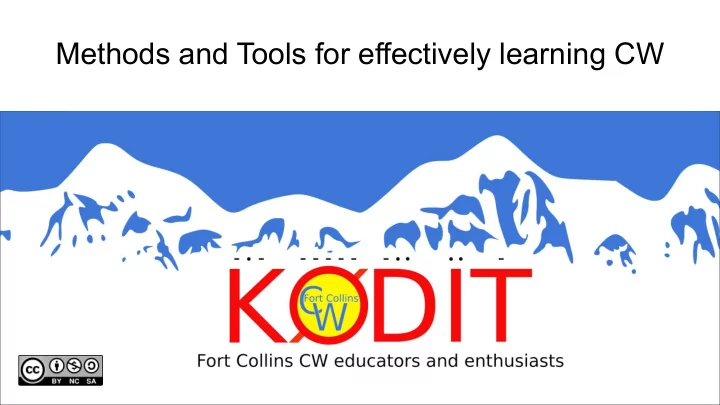

Methods and Tools for effectively learning CW
ge·stalt / ɡ ə ˈ SHtält/ 1. an organized whole that is perceived as more than the sum of its parts.
It is up to you ● There is no magic system to learning morse code ● It is up to you to put in the effort ● All I am trying to do here is give you the tools and methods that will give you the best chance at success ● Ultimately it is up to you and your level of commitment
CW is FUN ● Work more DX ● Get more QSO’s in contests ● Makes successful QRP easy ● Simple home made gear ● Lots of portable activities: POTA, SOTA, etc.
Overview ● Koch method ○ History ○ Analysis and Criticisms of other methods ○ What is the Koch method ● LCWO ● Training tips and pitfalls ● Suggested progression ● Sending CW ● Tools and resources
Koch method - History Ludwig Koch ● Psychologist at Die Technische Hochschule, Braunschweig, Germany ● His goal was to discover the most efficient way to teach the Morse code to prospective radiotelegraph operators ● He ran a series of tests to determine how the code is comprehended by experienced commercial radio operators ● From these tests it was concluded that experienced operators recognize a code character by its overall acoustic pattern (Gestalt)
Analysis and criticism of previous teaching methods - How not to learn CW ● Visualization, mnemonics, and other translation gimmicks create a useless detour and added step to the process of comprehension ● Slow sending destroys any unity, or coherent sound-patterning, practically forcing the learner to count the dits and dahs ● At each increase in speed everything sounds different, and the learner virtually has to start over again.
What is the Koch method? ● Introduce Morse characters to the student at a character speed fast enough for them to be perceived as an acoustic unity ● Introduce new characters whose sound patterns are distinctly and obviously different. ● Introduce a new character when the learner is getting at least 90% correct copy ● Introduce one new letter at a time integrated into the group of letters already learned, until finally the whole alphabet is complete
lcwo.net ● Koch method lessons ● Code Groups ● Plain Text Training ● Word training ● Callsign Training
Training tips and pitfalls Do NOT use any visual chart or form representing characters as dashes and ● dots. Human visual impression is so strong that it will almost invariably lead to analyzing sounds ○ into into dashes and dots Copy at a character speed of at least 20 wpm from the very start ● This will promote the sense of acoustic unity and bypass the 10 wpm plateau completely. ○ If you find that you are counting dits and dahs, increase your speed to 25 or even 30 wpm ○ Use Farnsworth spacing as needed to be able to copy the letters ● In the 1950s, Donald R. Farnsworth (W6TTB) invented a method that would allow morse learners ○ to practice at the full target character speed. Characters are played at target speed, but extra spacing is added between characters to give you time to think.
ge·stalt / ɡ ə ˈ SHtält/ 1. an organized whole that is perceived as more than the sum of its parts.
Learning CW is like learning a language. It takes time, practice, and persistence. 1. Learn morse code using lcwo.net. Keep your character speed at 20 wpm, and adjust Farnsworth spacing as necessary to be able to make progress. Go through all the lessons to learn the characters of morse code. This is grueling work but it will pay off. 2. Start listening to on air QSO's. You will find that even though you know morse code, you probably have no idea what people are saying to each other. Again, CW is very much like a language with its own vernacular, structure, abbreviations, and dialect. Listening to real on air QSO's will help you get the feel for these nuances of the language. This step is getting you ready for being "on air capable". 3. Get on the air. You should be able to copy at an effective speed of 10-15 words per minute. You will be very tempted to write everything down, rather than assembling letters into words in your head (head copy). Do everything in your power to start working on practicing head copy at this point. You will find very quickly, that writing will limit your ability to increase your speed. 4. Utilize various tools to work on improving your effective speed, and reducing the amount of farnsworth spacing that you need.
Sending CW ● USE PADDLES! ○ Reinforces proper timing and spacing from the start ○ Will allow you to increase your speed more quickly ● Use CW Decoding WebSDR to practice ○ Kiwi SDR https://sdr.hu/map ● UNI-730A Paddle ○ Available on ebay for ~$50 ● Left or right handed ○ Dah is on index ○ Dit is on thumb ● Send non-dominant, or dominant
Tools and resources ● LCWO - https://lcwo.net/ ○ Word copy practice ○ Callsign copy practice ○ Random code group practice ○ Basic plain text practice ● Seiuchy Morse - http://seiuchy.macache.com/ ○ Head copy practice ○ Full QSO copy practice ● CW Academy level 2 Practice files - https://cwops.org/level-2-practice-files/ ○ Head copy practice ● FoCo CW - https://fococw.com/ ○ Weekly round table: Tues. 8pm on 7.118 ○ Scheduled practice ○ Mailing list
Demo ● T ● E ● A ● N ● TEN ● NET ● EAT ● ATE
Questions?
Recommend
More recommend